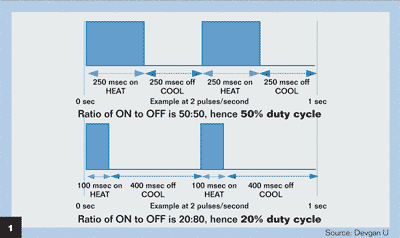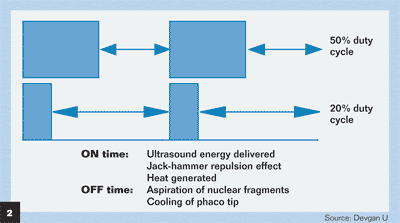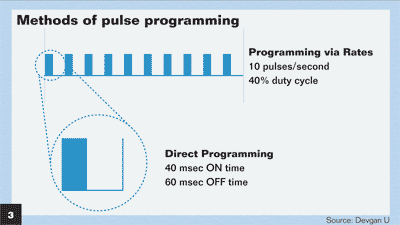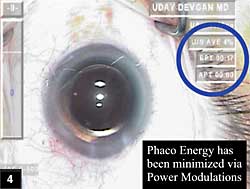Pulse programming with variable duty cycle modifies energy delivery

It is possible to reduce the phaco time and energy during cataract surgery using phaco power modulations, which makes surgery safer and speeds postoperative recovery of vision.
 Uday Devgan |
When we modulate the phaco energy using the pulse mode, we deliver pulses of energy at a surgeon-defined rate of pulses per second (pps), which is the number of cycles per second. The default cycle for pulse mode is to have the phaco energy on and then off for equal periods (50:50), thus giving a duty cycle of 50%.
We can vary this duty cycle to modify the energy delivery: If we want to deliver less energy and allow more time for aspiration and cooling, we can choose a lower duty cycle such as 20%, where the energy on:off ratio is 20:80.
Alternatively, we can increase the duty cycle to deliver more energy for better nucleus cutting at the expense of more heat generated, such as with a duty cycle of 70%, where the on:off ratio is 70:30 (Figure 1).
The variable duty cycle allows the surgeon to change the on:off ratio for each cycle. During the “on” phase, the ultrasound energy is being delivered, therefore the cutting ability increases, as does heat generation and the jackhammer-like repulsive effects of phaco. During the “off” phase, there is cooling of the phaco tip and time for aspiration of nuclear fragments (Figure 2).
Decreasing the duty cycle decreases the total phaco energy delivered into the eye, while increasing the duty cycle increases the energy. Note that simply changing the pulse rate (pulses per second) does not change the total phaco energy.
|
|
Selecting settings
The default duty cycle of 50% is a good starting point for most surgical techniques. I suggest then titrating the duty cycle downward until just before you can detect a decrease in your nucleus cutting ability. Most surgeons will not notice the difference between 50% and 40% duty cycles, yet the savings in total phaco energy can be significant.
|
Image: Devgan U |
A more direct way of programming in pulse mode is providing the actual “on” and “off” times that you wish to use. For example, with traditional programming, a surgeon can specify 10 pps with a duty cycle of 40%. This means that each on:off cycle will be 100 msec (thus, 10 per second), of which 40 msec will be “on” time and 60 msec will be “off” time. With direct programming, the surgeon simply chooses the desired “on” and “off” times of 40 and 60 msec, respectively (Figure 3).
For direct pulse programming, high pulse rates can be achieved with “on” and “off” times as short at 4 msec (giving an effective pulse rate of 125 pps since each cycle is 8 msec). All of the newer generation phaco machine platforms are able to vary the duty cycle in pulse mode, though their nomenclature and method of programming may be slightly different.
If you are currently using only continuous phaco mode, I encourage you to try pulse programming with a variable duty cycle. Using parameters such as 4 msec on and 6 msec off (an effective pulse rate of 100 pps and a 40% duty cycle), you will likely be able to continue doing your same surgical technique with the benefit of less phaco energy delivered into the eye (Figure 4). Your patients will achieve sharper vision immediately postop and you’ll likely be rewarded with increased satisfaction and word-of-mouth referrals.
Next column, we’ll explain “burst” mode, which is fundamentally different from pulse mode, but achieves the same end-point of decreased phaco energy.
For more information:
- Uday Devgan, MD, FACS, is assistant clinical professor, Jules Stein Eye Institute, UCLA. Dr. Devgan has no financial interest in any of the products mentioned and he does not accept honoraria for ophthalmic industry speaking, writing or consulting. Dr. Devgan can be reached at devgan@ucla.edu or +1-310-612-3993.




